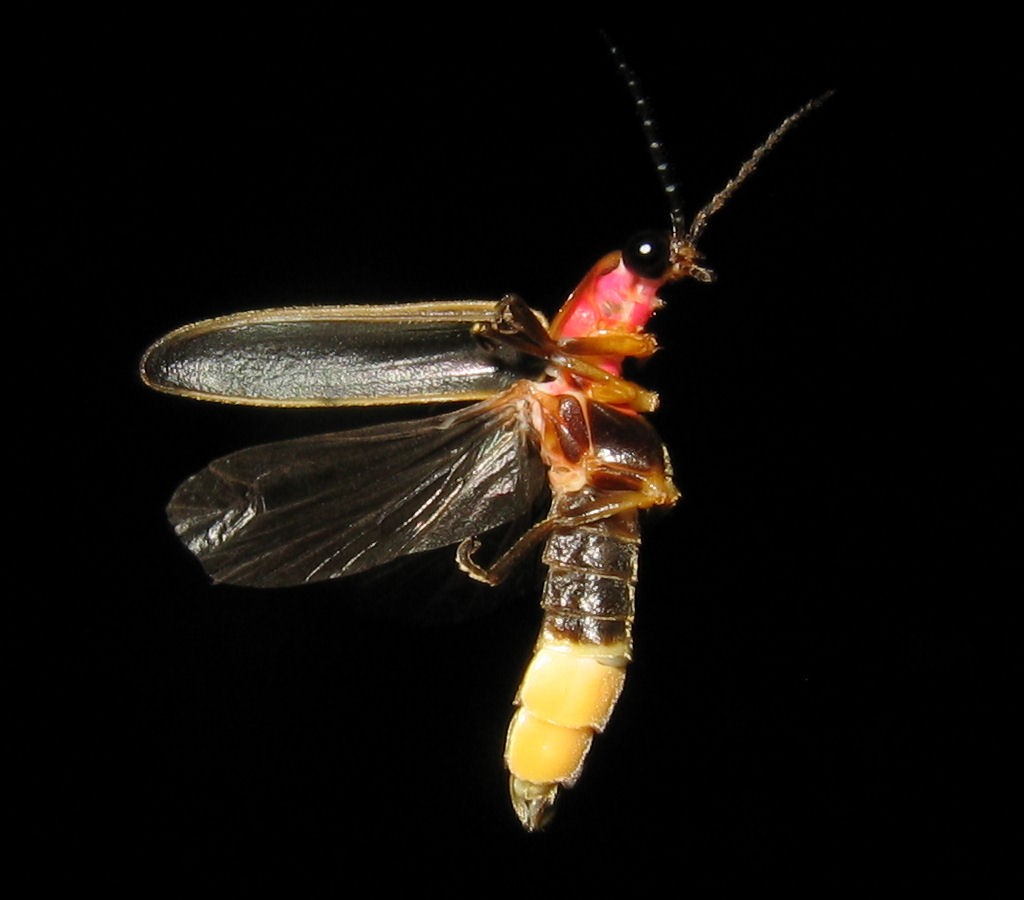By Rick Borchelt

It’s been a spring with a lot of days that seemed like we were in a refrigerator, but at last the warm and humid days of summer are upon us. In late April, after showers that left the yard damp and misty, what I consider the real harbinger of summer days rose from the wet ferns and hostas in my backyard — a single firefly whose Morse code flashes punctuated the darkness around me.
But I did think he and I were alone for the evening, and as if on cue, soon there were maybe a hundred fireflies, all flashing as they flew high into the dark trees in the steamy night.
There are more than 2,000 kinds of fireflies in the world, about 150 of them in the U.S. and Canada. Despite their common names — firefly and lightning bug — they are neither flies nor true bugs; fireflies are beetles, related to scarabs and weevils and tiger beetles — and all the rest of the huge beetle clan, as well.
Maryland is home to about eight kinds of fireflies, not all of which are flashers as adults. Two non-flashing species are found here, the winter firefly and the black firefly. Both species are active in daylight, so if they did flash, their pulsing signals would be drowned out by the sunlight. The firefly we most often see in College Park yards is the Eastern firefly (Photinus pyralis), which is also known by its catchier common name, big dipper firefly. This species does flash; indeed, it puts on a stellar sparkling display.

Courtesy of Terry Priest
Fireflies flash as part of their mating dance, with the male declaring “I’m ready,” and the female signaling “I’m willing!” Scientists believe that this behavior originated some 100 million years ago, when flashing began in larvae to signal to predators that they were distasteful or downright poisonous. Over time, the flashing evolved into the complex semaphore signaling, the mating rituals, that adult fireflies use today.
Fireflies have species-specific flashing patterns — single flashes, double flashes, dot-dot-dash sequences, or flashes that follow a flight path; the big dipper firefly we see here in Maryland flashes as it flies in a J-shaped arc. Some firefly species synchronize and flash in unison, lighting up skies with astonishing displays. In South Carolina’s Congaree National Park, thousands upon thousands gather to punctuate dark May nights every year in their mating dance.
Female fireflies generally respond only to the males of their specific species — with one notable exception.
Females of the genus Photurus deliberately look for the flashes of big dipper and other Photinus group males and then lure them in by mimicking the female flash pattern of the males’ own species. When a male comes in expecting to mate with one of these cunningly deceptive females, though, he has a rude surprise waiting —she severs his neck and eats him. Not content to lie in wait, a female sometimes goes on the hunt herself and tracks down the Photinus male, using his flash pattern as her target.
But when the right male meets the right female and all goes well, she’ll lay eggs in dense leaf litter on a forest floor, in tall meadow grasses or in firefly-friendly yards. By summer’s end, those eggs hatch into larvae that then spend up to two years prowling around looking for slugs, snails, earthworms and other soil invertebrates to eat. They attack their prey, immobilizing them with a fluid that paralyzes and then liquefies them. The flying flashers we see seldom live for more than a few weeks on the wing.
Fireflies, which excrete toxic fluids to defend themselves, have few natural enemies, aside from other fireflies. But they do face challenges, and many firefly species are in decline — some precipitously so. The biggest problem they face today is habitat destruction; our manicured lawns might as well be deserts, as far as fireflies are concerned. Larvae need leaf litter and deep shade to survive, and the adults need darkness — they can’t find each other in the glare of a streetlight or the flooding brightness of a backyard security light. During firefly season, I turn off the porch lights and dim the motion sensors, and I often see hundreds in a single night, blinking their beacons into the trees of my firefly-friendly yard.
Greenbelt has established a sanctuary in Stream Valley Park for these iconic insects, with nearby parking at St. Hugh’s School, on Crescent Road. This light-free firefly refuge typically hosts watch parties a few nights during peak firefly season; you can take a lawn chair and settle in for the show, which begins around dusk. This year’s watch parties will be on July 10 and 17. (For more information, go to greenbeltmd.gov/Home/Components/Calendar/Event/4381/18)
But don’t wait too long to enjoy this summer spectacle; as we move into late July or August, the firefly’s season in the air will be over.
—
Have questions for Rick about the world of nature in and around the city, or suggestions for future College Park Wild columns? Drop him a note at rborchelt@gmail.com.







